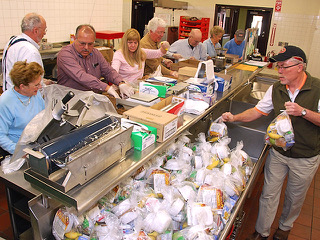The Hungry Kids Project Provides Food to Families Who Need it, So Students Come to School Ready to Learn
Carm Staker built Humboldt Unified School District’s Hungry Kids Project on the foundation of her vision to ensure children were getting enough to eat. Through the project, schools send weekly food packs home with children whose families qualify for free and reduced meal prices.
One day, Carm received a phone call that showed her vision was becoming a reality. It was from a mother whose children brought home the weekly food packs, and when Carm told her she was the Coordinator of the Hungry Kids Project, the woman said:
“I want to thank you. My two kids got food packs starting last fall and this spring. My husband and I had both lost our jobs. The food packs have been a blessing and helped us immensely. Now, I want you to pass those on to someone else. We’ve both gotten jobs again and are doing fine. We don’t need them anymore. But thank you, and tell the people involved how much they helped our family.”
Since the program started eight years ago, many of the families who received food packs have improved their lives.
During the 2018-2019 school year, Hungry Kids served an average of 623 students per week, a six-percent increase from 587 the previous year.
Broken down into school districts, the numbers look like this:
- Chino Valley Unified School District: 289 per week, up from 245
- Mayer Unified School District: 100 per week, up from 85
- Humboldt Unified School District: 147, down from 165
- Prescott Unified School District: 87, down from 95
Taking a Closer Look: The Details
Food: The purpose of the Hungry Kids Project is to ensure children come to school every Monday, ready to learn. Balancing nutrition, what kids eat, and a budget, the Hungry Kids Project sends weekend food packs home at a cost of about $6.50 – $7.50 for two or three days of meals (depending on whether each school district operates on a four- or five-day schedule). Three components are necessary for a successful Hungry Kids Project: school staff, volunteers, and contributions.
School Staff: Any staff-identified child is eligible to receive food through the Hungry Kids Project. Staff members (nurses, counselors, or front office staff) ensure identified children receive their packs. Most food services help the Hungry Kids Project by ordering food we pay for with donations.
Volunteers: Among the four districts, almost 150 volunteers pack food packs. Additional volunteers assist with buying food, usually at sale prices.
One new component of the Hungry Kids Project is the Food Neighbor Program. Neighborhood Coordinators distribute “Green Bags” to neighborhood friends, which are collected every other month. On the second Saturday of all even-numbered months, coordinators bring the Green Bags to central locations in Prescott and Prescott Valley. At that time, the programs receiving the food (including the Hungry Kids Project) bring volunteers to accept the food.
Contributions: All financial contributions are used to purchase food. Individuals and groups (as varied as service clubs, businesses, Community Foundations and special interest groups) support the efforts of the Hungry Kids Project. There isn’t space to list them all, but everyone involved with the Hungry Kids Project appreciates their support.
Contributions: ACF of Yavapai (Hungry Kids on memo line)
300 E. Willis St. Prescott, AZ 86301
Tax Credit: Chino Valley Education Foundation,
650 E. Center St. Chino Valley, AZ 86323
People who are interested in helping with the Hungry Kids Project can contact Bob Painter at prescott9@msn.com or Jack Miller at jackfoodsafety@gmail.com.
People who wish to contribute can contribute to ACF of Yavapai (Hungry Kids on memo line) at 300 E. Willis St. Prescott, AZ 86301. Tax credit information: Chino Valley Education Foundation, at 650 E. Center St. Chino Valley, AZ 86323.

